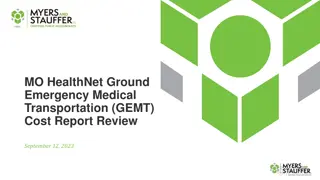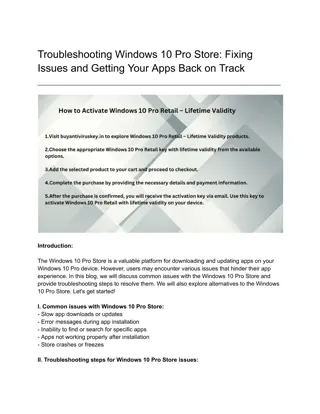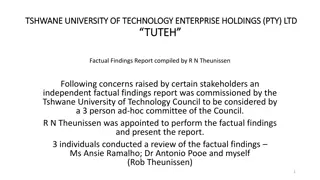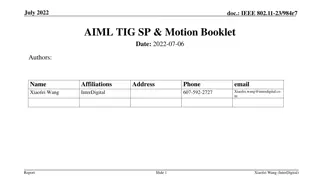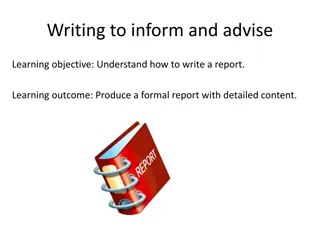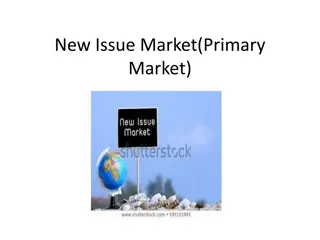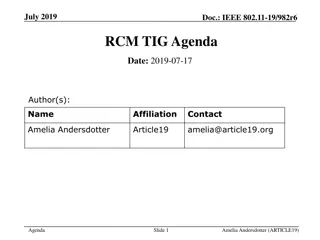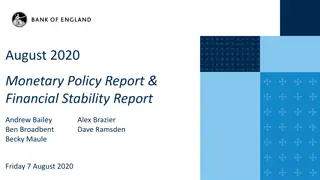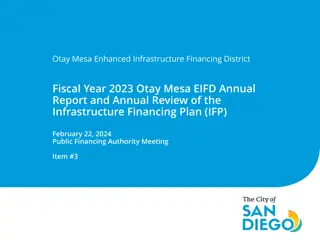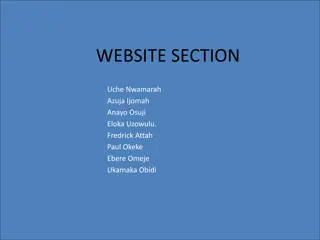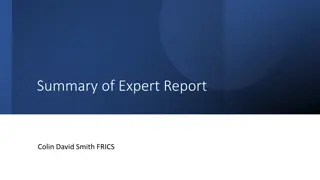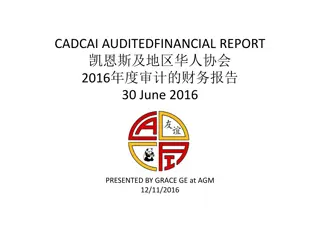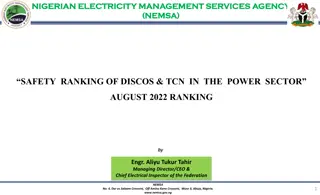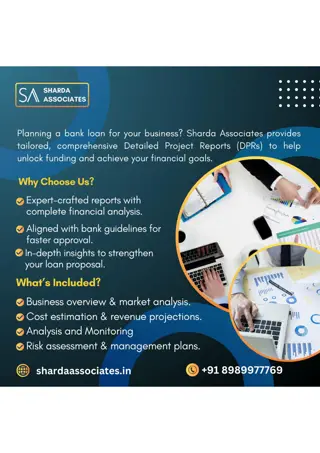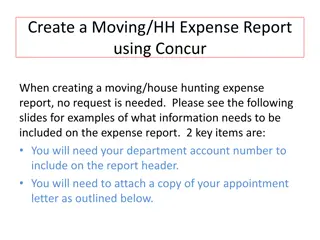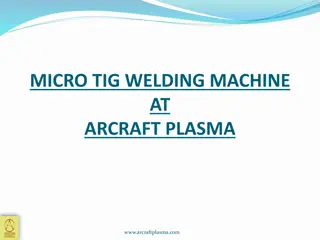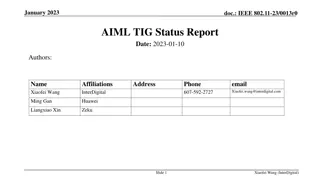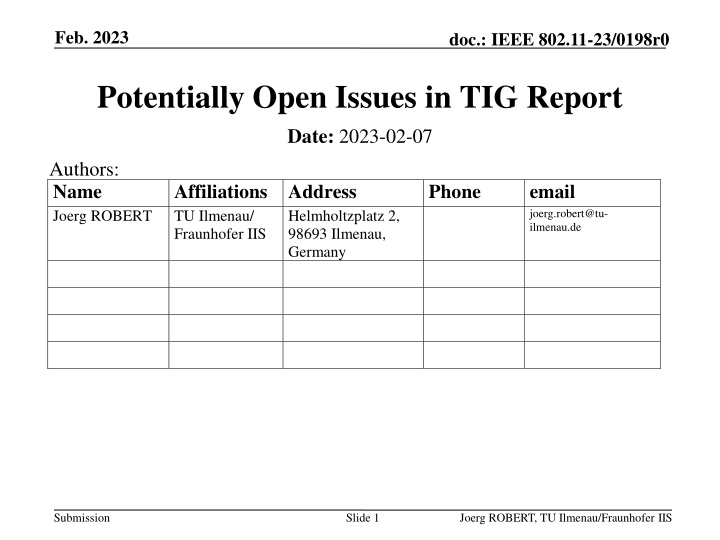
Potentially Open Issues in IEEE 802.11-23/0198r0 Document
Discover potentially missing items in the current version of the TIG report related to IEEE 802.11-23/0198r0, addressing issues such as full-duplex operation challenges, backscatter technologies' modulation details, frequency regulation considerations, and potential problems with energizers, with proposals for enhancements and clarifications.
Download Presentation

Please find below an Image/Link to download the presentation.
The content on the website is provided AS IS for your information and personal use only. It may not be sold, licensed, or shared on other websites without obtaining consent from the author. If you encounter any issues during the download, it is possible that the publisher has removed the file from their server.
You are allowed to download the files provided on this website for personal or commercial use, subject to the condition that they are used lawfully. All files are the property of their respective owners.
The content on the website is provided AS IS for your information and personal use only. It may not be sold, licensed, or shared on other websites without obtaining consent from the author.
E N D
Presentation Transcript
Feb. 2023 doc.: IEEE 802.11-23/0198r0 Potentially Open Issues in TIG Report Date: 2023-02-07 Authors: Name Joerg ROBERT Affiliations Address TU Ilmenau/ Fraunhofer IIS Phone email joerg.robert@tu- ilmenau.de Helmholtzplatz 2, 98693 Ilmenau, Germany Submission Slide 1 Joerg ROBERT, TU Ilmenau/Fraunhofer IIS
Feb. 2023 doc.: IEEE 802.11-23/0198r0 Abstract The current version of the TIG report already covers most items. However, some parts in 11-22/1562r5 may be still missing. This documents proposes potentially missing items. Submission Slide 2 Joerg ROBERT, TU Ilmenau/Fraunhofer IIS
Feb. 2023 doc.: IEEE 802.11-23/0198r0 Full Duplex Operation Section 4.2 in 11-22/1562r5 already mentions different technical challenges. However, a main issue is due to the required full-duplex operation for backscatter devices. This is especially a problem in case of mono- static operation that is implied by the pictures in the use-case section. These problems were already discussed in the Full Duplex TIG back in 2018. Proposal: The findings of the Full Duplex TIG in 11- 18/498r8 should be added to the challenges as this will have a major impact on the potential use-cases Submission Slide 3 Joerg ROBERT, TU Ilmenau/Fraunhofer IIS
Feb. 2023 doc.: IEEE 802.11-23/0198r0 Basic Introduction to Backscatter Technologies The current draft already shows potential implementations of backscatter technologies and shows the hardware implementation However, a detailed description on the actual modulation is missing. Proposal: Additional text to describe the modulation should be added. This is especially important to underline the requirements for specific energizer waveforms. Submission Slide 4 Joerg ROBERT, TU Ilmenau/Fraunhofer IIS
Feb. 2023 doc.: IEEE 802.11-23/0198r0 Frequency Regulation The system does not yet mention the issue of frequency regulation. This is especially important as most calculations are only feasible in countries following FCC 15.257. Therefore, the link budget calculations in section 4.4.1 may be too optimistic. Proposal 1: Add existing text (with modifications) as proposed in 11-23/89r0 Proposal 2: Review link budget in section 4.4.1 and add figures for other countries Submission Slide 5 Joerg ROBERT, TU Ilmenau/Fraunhofer IIS
Feb. 2023 doc.: IEEE 802.11-23/0198r0 Potential Problems with Reasonability of Energizers Continuous transmission of energy to energize AMP devices may not be reasonable. Potential issues are e.g.: Problematic in terms of frequency regulation (duty cycle, power limitations, ) Potential long-time exposure to strong electromagnetic fields In Germany transmit power of 10W EIRP or more requires permission of authorizes with proof of protection of humans. Proposed parameters in section 4.4.1 are close to critical values allowed by law (in Germany: Bundes-Immissionsschutzgesetzes (Verordnung ber elektromagnetische Felder - 26. BImSchV) ) Question: How do we address these topics? Submission Slide 6 Joerg ROBERT, TU Ilmenau/Fraunhofer IIS
Feb. 2023 doc.: IEEE 802.11-23/0198r0 Summary This document mentions some aspects that are not yet (well-)addressed in the TIG report The missing topics may be relevant for the definition of a future standard Me and my team would volunteer to draft the missing sections for the TIG report Submission Slide 7 Joerg ROBERT, TU Ilmenau/Fraunhofer IIS

